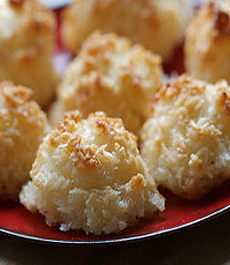TIP OF THE DAY: Off-Season Coconut Macaroons

|
If you like coconut, don’t wait until Passover* to make coconut macaroons. They’re a great treat year-round, and gluten-free. Bring them as house gifts: They travel well without breaking. We adapted this recipe from one by Serena Rain of VanillaQueen.com, purveyor of top-quality vanilla beans, extracts, pastes, powders, sugars and salts. You don’t need to add chocolate to macaroons; but if you want to, there are two options: You can incorporate the orange peel into the dough or the glaze. We like the “lift” it gives to the recipe. 1. PREHEAT the oven to 350°F. Line baking pans with parchment paper. 2. COMBINE the ingredients in a medium bowl and stir until well incorporated. Use a spoon to scoop tablespoon-sized mounds of the coconut “dough.” Shape into round balls and place on the parchment paper. Alternative: You can drop the dough as unshaped mounds. See the difference between the top photo (dropped) and the bottom photo (shaped). 3. BAKE for about 20 minutes or until golden brown (aim for the color in the center photo). Let cool. 4. MAKE the glaze. Place the chocolate in a bowl and microwave for 30 seconds. Stir, and if necessary, heat for 30 more seconds until fully melted. Dip the bottoms of the cooled macaroons into the chocolate. Alternatively, place the cookies on a tray lined with parchment paper and drizzle the tops with chocolate; let cool until set. Some people prefer the glaze on top: a chocolate dome. Take your pick. |
|
|
THE HISTORY OF MACAROONS Macaroons appeared in the late 15th or early 16th century in Italy. The historical record isn’t clear, but they are believed to have been created by monks. There were thousands of monasteries in medieval Europe, and monks created different types of beers, brandies and liqueurs, cheeses, pretzels, sweets, wines and spirits. The first macaroons were almond meringue cookies similar to today’s amaretti cookies, with a crisp crust and a soft interior. They were made from egg whites and almond paste. Italian Jews adopted the cookie because it had no flour or leavening‡, so could be enjoyed during the eight-day observation of Passover. It was introduced to other European Jews and became popular as a year-round sweet. Over time, coconut was added to the ground almonds and, in some recipes, replaced them. Today in the U.S., coconut macaroons are the norm. Macaroons came to France in 1533 with the pastry chefs of Catherine de Medici, wife of France’s King Henri II. In France they evolved into delicate meringue cookie sandwiches filled with ganache or jam. Here’s more about the different types of macaroons. †Almond meal, or almond flour, is ground from whole, blanched sweet almonds. The nuts are very low in carbohydrates and very nutritious. ‡Leavening is the agent that raises and lightens a baked good. Examples include yeast, baking powder and baking soda. Instead of these, macaroons (all types) are leavened with egg whites.
|
||




